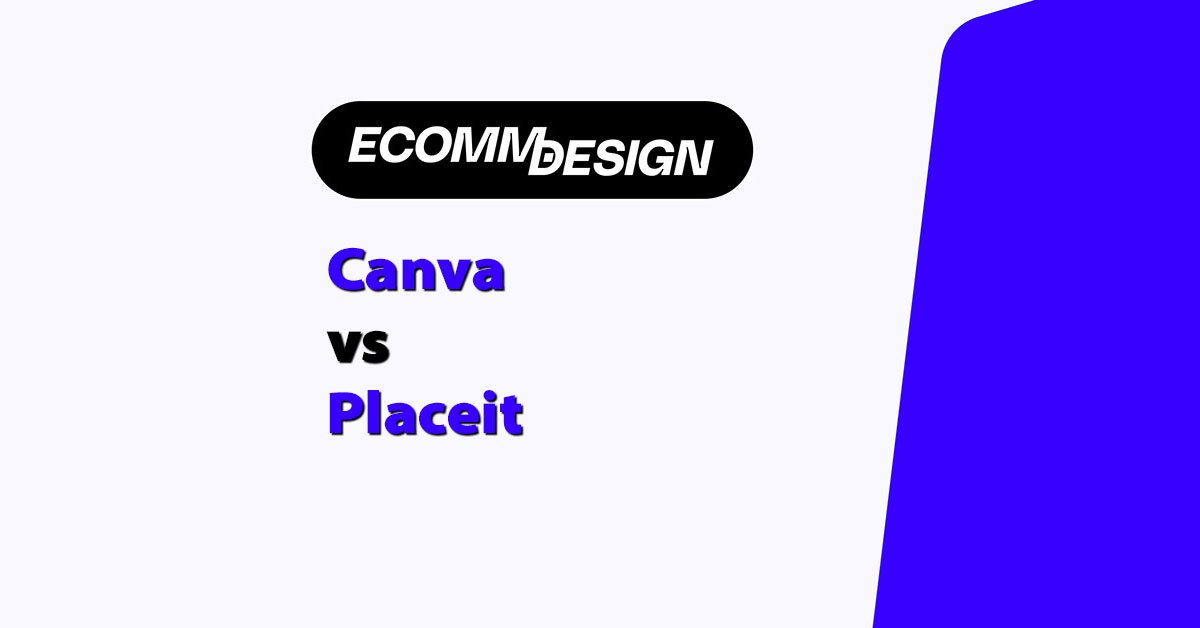
If you’re running an ecommerce store and trying to decide between Canva and Placeit, here’s the quick answer:
Canva is the better option for building brand visuals, social content, and team design systems.
Placeit is better for quick, realistic product mockups, videos, and designs made to showcase products in context.
I’ve used both tools for over a decade across client projects, product launches, and campaigns—and here’s the full breakdown.
What Is Canva?
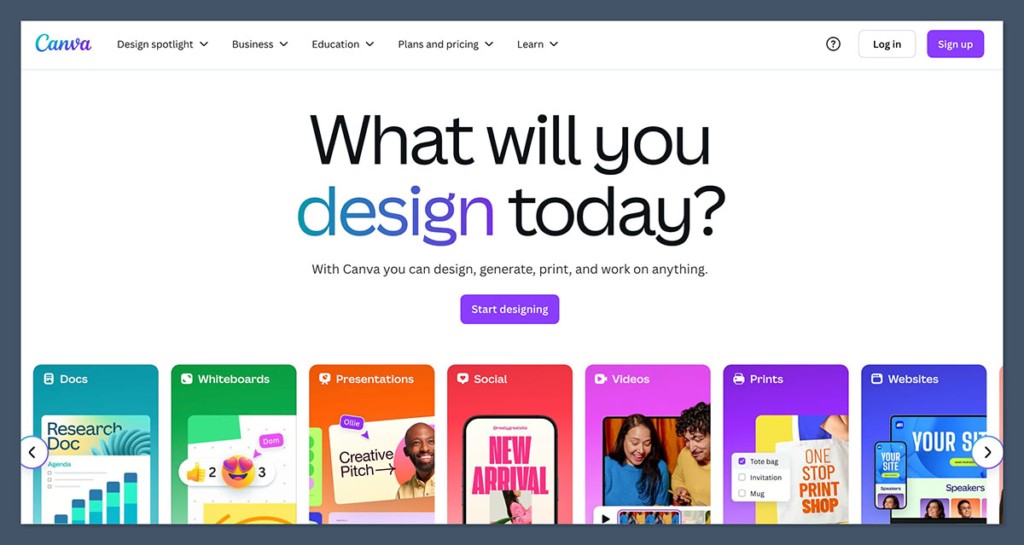
I started using Canva back when they were just launching their Pro tier. It was instantly clear this wasn’t Photoshop—it was made for speed and simplicity.
Canva is a cloud-based design tool that lets you create just about anything: product promos, infographics, Instagram stories, packaging designs, even email headers.
Here’s why it works so well for ecommerce:
- Branding in a Box: You can set up brand kits with your colours, logos, fonts—so your team stays consistent across every visual.
- Templates Galore: They’ve got thousands of templates for Facebook Ads, product carousels, Pinterest pins, influencer media kits—you name it.
- Team Friendly: Share designs, comment live, and assign projects. It’s Figma-lite, without the learning curve.
- App Integrations: Canva connects with Dropbox, Google Drive, Shopify, and more, which makes exporting or embedding designs seamless.
Canva isn’t built for high-end custom design work. But if you need to produce polished designs fast, and collaborate with a team, it’s excellent.
Canva Pros:
- Easy to use, with pro-grade results
- Brand kits and team collaboration tools
- Massive library of assets (photos, icons, fonts)
- Great for multi-platform campaigns
- Solid app and mobile support
Canva Cons:
- Weak for mockups and lifestyle previews
- No true smart object editing like Photoshop
- Design styles can feel “templated” or overused
- Videos are limited in functionality
What Is Placeit?
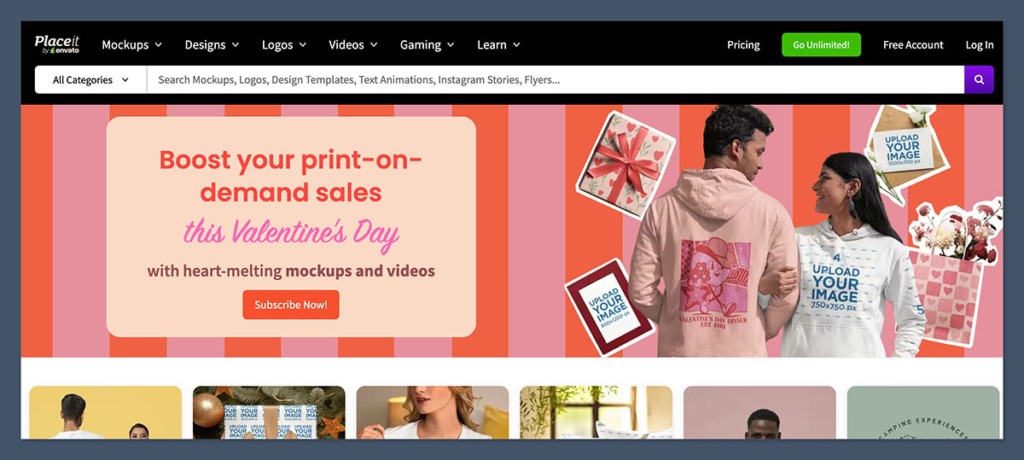
Placeit is owned by Envato (the same folks behind Themeforest), and they’ve zeroed in on one thing: mockups and branded content for ecommerce sellers.
You’re not designing from scratch here. You’re uploading a design (like a logo or T-shirt graphic), then dropping it onto a pre-shot image or video.
Think lifestyle shots, packaging scenes, or tech product setups—without ever needing a photo shoot.
Here’s what Placeit is great for:
- Product Mockups: Upload your design and it’s placed on T-shirts, mugs, iPhones, books, hoodies—everything.
- Videos Made Easy: Quick social ads, YouTube intros, and Instagram reels with drag-and-drop scenes.
- No Design Skills Needed: No layers, no grids, no canvas. Just upload and download.
- Massive Template Library: Over 90,000 templates, mostly centered around products and merch.
If you’re selling on Etsy, Amazon, or your own Shopify store, Placeit gives you instant visuals that look like they cost hundreds.
Placeit Pros:
- Incredible mockup variety and realism
- Very easy to use for beginners
- Fast exports of images and videos
- Ideal for POD, merch, and product marketing
Placeit Cons:
- Less design flexibility
- Not good for building full brand visuals
- Interface feels outdated at times
- No real design control beyond drag-and-drop
Summary Verdict:
Use Canva if you want control, creativity, and cross-platform design.
Use Placeit if you need mockups, fast branded content, or you’re in the POD/ecommerce game.
Head-to-Head Features
Templates
Canva:
With over 250,000+ templates covering everything from Facebook ads to product brochures, Canva has the most variety by far.
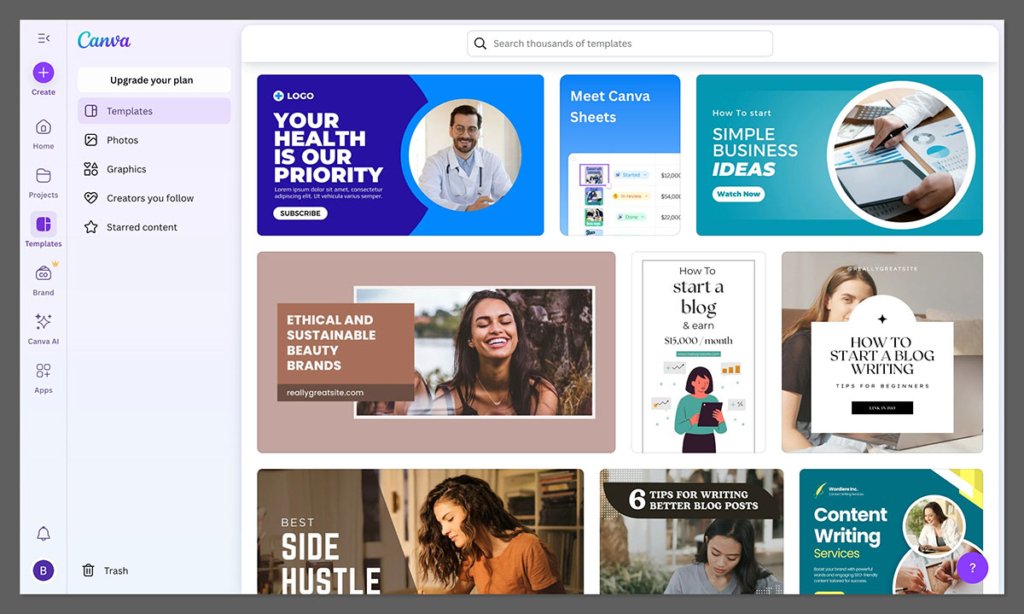
Templates are designed to be easy to edit, even for non-designers. You can quickly change fonts, colours, and layouts while sticking to your brand guidelines.
Placeit:
Placeit’s library is narrower but highly focused.
Almost every template is geared toward showcasing a product. This includes mockups for apparel, digital screens, packaging, and devices.
Unlike Canva, you don’t get multipurpose design templates like infographics or email headers.
Verdict: Canva wins for breadth of use. Placeit wins if you need mockups only.
Mockups
Canva:
Canva offers a few mockup templates for things like apparel, packaging, and tech.
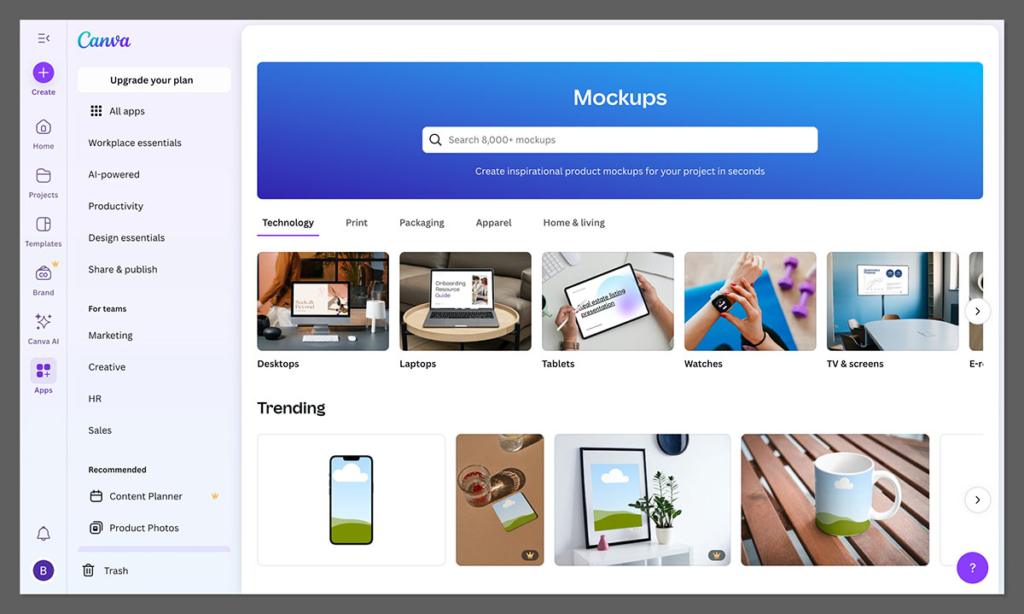
But they’re limited, mostly static, and often don’t have realistic depth or lighting.
Placeit:
This is where Placeit shines.
You get access to over 70,000 mockups for T-shirts, mugs, iPhones, laptops, posters, and more—each shot with real models, environments, and perfect lighting.
It’s ideal for creating store-ready product visuals without needing a camera.
Verdict: Placeit dominates mockups—Canva isn’t in the same league here.
Video Editing
Canva:
Canva has basic video functionality.
You can add transitions, music, text overlays, and animations. It works for social media videos, but anything more complex (e.g. product demos) requires another tool.
Placeit:
Placeit’s video tools are fully templated.
You choose a scene, upload your product or logo, tweak the copy, and export. The downside? You can’t change much. The upside? It’s done in minutes.
Perfect for ads, promos, and intro/outro animations.
Verdict: Canva is better for editing flexibility; Placeit wins for fast templated product videos.
Customisation
Canva:
You get full design freedom—move things around, change every layer, import SVGs, animate individual elements. You can build from scratch or heavily edit templates to fit your style.
Placeit:
You’re locked into the layout. You can’t move items or layers.
You’re just replacing text and logos or switching background colours. This is great for speed but limiting if you need creative control.
Verdict: Canva is for designers. Placeit is for marketers who just need it done.
Brand Kit
Canva:
Canva Pro allows you to save your brand colours, fonts, logos, and templates. This helps keep everything consistent across your social media, product pages, and packaging.
Placeit:
There’s no brand kit or reusable template system. Every time you make a new design, you start from scratch unless you clone an old project.
Verdict: Canva wins for long-term brand consistency.
Collaboration
Canva:
Canva is built for teams. You can invite team members, leave comments, track changes, and even assign templates for use across different departments.
Placeit:
This is a solo tool. You design, download, and upload. No team features or design-sharing infrastructure.
Verdict: Canva is way better for collaboration.
AI Features
Canva:
Canva’s AI tools are surprisingly solid. Magic Resize lets you repurpose one design into multiple formats instantly (e.g., IG Story to Pinterest pin). There’s also AI image generation, AI copy, and layout suggestions.
Placeit:
No AI tools. Everything is template-based and static.
Verdict: Canva’s AI saves serious time, especially for content teams.
Learning Curve
Canva:
There’s a little bit to learn—especially if you’re setting up brand kits or using Pro features. But it’s intuitive, and the tutorials are excellent.
Placeit:
Zero learning curve. You can create your first product mockup or video in under 2 minutes. But the simplicity means it plateaus quickly in terms of what you can do.
Verdict: Placeit wins for beginners. Canva offers more depth for experienced users.
| Feature | Canva | Placeit |
|---|---|---|
| Templates | 250,000+ across categories | 90,000+ mockups & assets |
| Mockups | Basic, limited options | Vast, photo-realistic |
| Video Editing | Lightweight, simple timeline | Fully templated, drag-drop |
| Customisation | Deep design control | Limited to input fields |
| Brand Kit | Yes (Pro only) | Not available |
| Collaboration | Real-time, team sharing | Not supported |
| AI Features | Magic Resize, Text to Image | None |
| Learning Curve | Low to Medium | Very Low |
Design Elements & Customization
As an ecommerce designer, what really matters isn’t just templates — it’s how far you can push them.
Whether you’re creating a branded Instagram story, a Black Friday banner, or a product packaging insert, you need control over the details.
Here’s how Canva and Placeit compare in real design use.
Canva: Full Design Control, Creative Flexibility
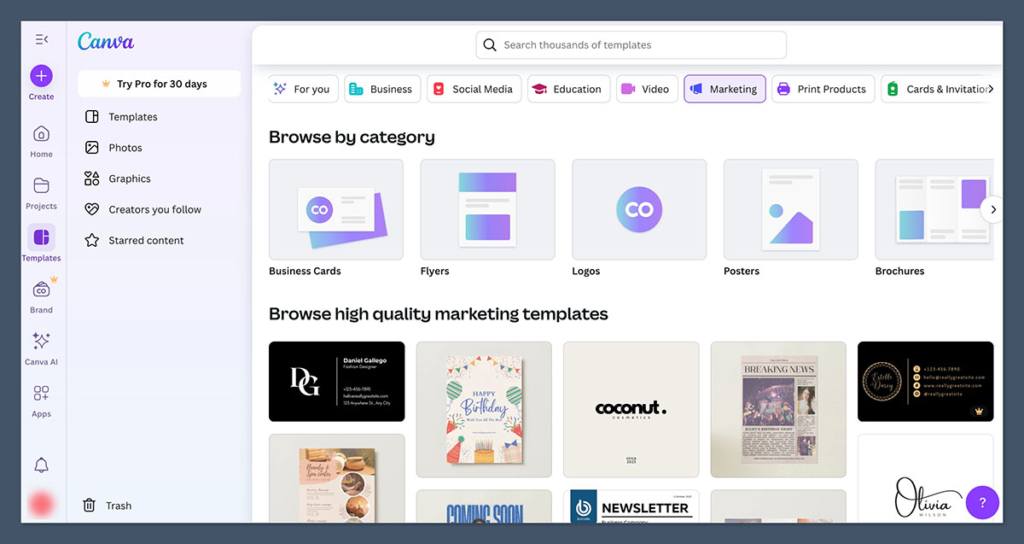
Canva gives you a blank canvas (pun intended) where you can build almost anything visually.
It’s not Photoshop, but for 90% of ecommerce design needs, it’s more than enough.
Here’s what makes Canva flexible:
- Element-Level Editing: You can move, rotate, crop, resize, layer, or animate any element on the page — including icons, photos, text, and shapes.
- Font Options: Canva offers thousands of fonts, including Google Fonts, and lets you upload custom fonts with Pro. Great for matching a brand’s typography.
- Image Editing: Basic photo editing tools like brightness, contrast, blur, duotone, filters, background remover (Pro), and smart cropping.
- Grids and Guides: Snap to grid, align elements, and use rulers for precision. Super useful for product label design or print assets.
- Custom Dimensions: You’re not limited to set sizes. You can create a 1080×1920 IG story, a 1200×628 ad, or a custom 3.5×2 business card layout.
- Brand Kit (Pro): Once set up, you can apply your colours and fonts in one click across any new project.
If you’re building brand visuals — whether it’s a hero banner for your Shopify store or carousel ads for Meta — Canva gives you control without being overwhelming. You’re free to start from scratch or remix templates heavily.
Biggest strength:
Canva adapts to your brand — not the other way around.
Placeit: Plug-and-Play with Tight Limits
Placeit works differently. It’s built on templates, and those templates are locked. You’re not designing in the traditional sense — you’re customizing pre-built scenes.
Here’s how Placeit handles customization:
- Upload-Only Logic: You upload your design (e.g. logo, T-shirt graphic, or thumbnail), and the template places it on the scene. You don’t move it. You don’t edit it.
- Fixed Layouts: You can change the background colour, headline copy, and sometimes font style or logo placement. But you’re always working within constraints.
- Text Tools: Very limited. You can’t adjust line height, kerning, or manually place text on the canvas. Everything is preset.
- Mockup-Specific Logic: It’s impressive for mockups — your design conforms to the folds of a hoodie or the screen of a laptop. But that magic only works in those narrow contexts.
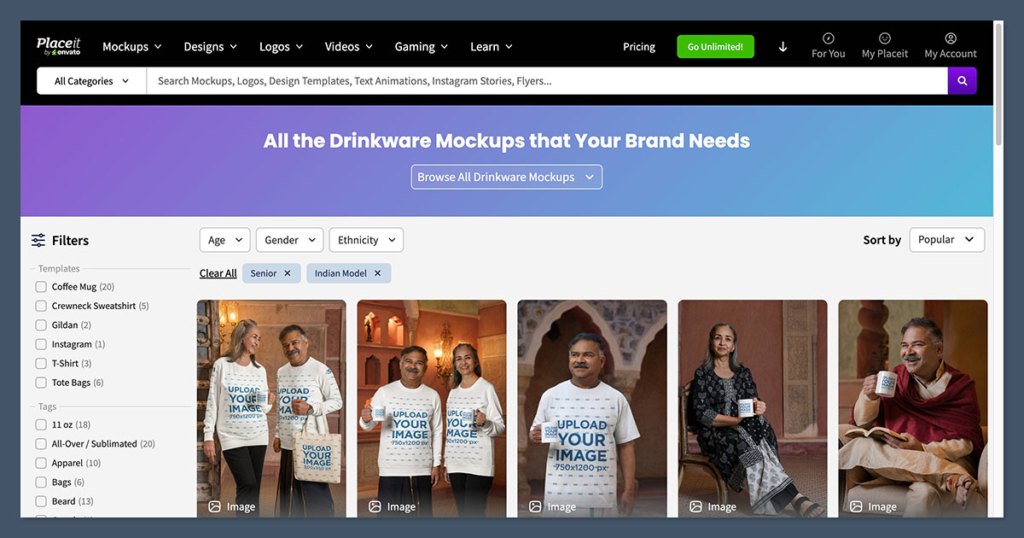
For someone who just needs a fast, sharp-looking mockup without opening Photoshop, it’s perfect. But if your business requires on-brand packaging, ads, and visuals across platforms, Placeit starts to feel restrictive.
Biggest limitation:
You can’t truly “design” — you just fill in the blanks.
Real-World Ecommerce Use Cases
Here’s how they perform in actual ecommerce design tasks:
| Design Task | Canva | Placeit |
|---|---|---|
| Instagram Ad Campaign | Fully customizable | Limited (video-based templates) |
| Product Packaging Insert | Design from scratch or templates | Not supported |
| Shopify Homepage Banner | Full control | Not suitable |
| Lifestyle Mockup for T-shirt | Weak or non-existent | Top-tier, realistic mockups |
| Amazon Product Infographic | Flexible and brandable | Not ideal |
| Custom Email Header | Easy with drag-and-drop | Not available |
| Animated Logo Reveal Video | Basic templates | Great templated intros |
Verdict:
Use Canva when your ecommerce brand needs to build a visual identity across channels—ads, content, site visuals, packaging, and beyond. It gives you room to design with intention.
Use Placeit when speed matters more than customisation—like when you need a T-shirt mockup or a product video preview in 3 minutes.
Integrations & Workflow
One of the biggest time killers in ecommerce design is managing tools that don’t talk to each other.
You’re juggling product pages, social posts, emails, and ad platforms — the more seamless your tools work together, the better.
So let’s break down how Canva and Placeit handle integrations and what that means for your workflow.
Canva: Built for Connected, Team-Based Workflows
Canva has clearly spent time making itself play nice with the rest of your stack. Whether you’re running a DTC store, dropshipping, or scaling with an agency, Canva fits into the system.
Key integrations that matter for ecommerce:
- Shopify: You can connect your Shopify store directly and design content inside Canva for your product pages or banners.
- Google Drive / Dropbox / OneDrive: Pull assets in and export final files to your shared folders, keeping things centralised.
- Meta (Facebook / Instagram): Publish directly to your social platforms — no need to download, re-upload, then schedule.
- HubSpot & Mailchimp: Create branded email assets and push them straight to your campaigns.
- Slack & Teams: Collaborate with your team, share mockups, and get real-time feedback.
- Zapier: Automate your design workflow. For example, auto-generate social graphics when you publish a blog post.
Why it matters:
In ecommerce, speed is money. Canva removes the download-reupload cycle. You design once, publish everywhere.
Bonus: Canva also autosaves and version-controls everything. That’s huge when you’re testing multiple creatives or working with VAs or remote teams.
Placeit: A Closed, Standalone System
Placeit doesn’t really integrate with anything. It’s designed to be a simple, isolated tool: upload your logo or design, export the mockup or video, and use it elsewhere.
What that looks like in practice:
- No native integrations: You can’t push designs directly into your store, CRM, or ad platforms.
- No file syncing: You’ll be manually downloading .PNG or .MP4 files and uploading them to wherever they need to go.
- No team sharing: Everything’s done in your account. No real-time editing, no comments, no approval flows.
- No CMS link-up: You can’t embed Placeit projects directly into Shopify, Webflow, or other platforms.
What’s the upside?
It’s simple. No confusion. But it also means more manual work, especially at scale.
Workflow tip:
Most ecommerce designers use Placeit like a “mockup vending machine.” You get in, get the asset, and get out. No long-term project management inside the platform.
Real-World Ecommerce Workflow Examples
| Workflow Scenario | Canva | Placeit |
|---|---|---|
| Design and schedule Instagram content | Design + publish directly | Download, upload elsewhere |
| Build email banner and sync to Mailchimp | One-click integration | Manual upload |
| Collaborate with a team on product launch assets | Comments, sharing, real-time | Not possible |
| Generate mockups for product listing | Limited options, manual | Fast, accurate mockups |
| Automate new product creatives via Zapier | Supported | Not supported |
| Store branding assets in one hub | Brand Kit + shared folders | None |
Verdict:
Canva is built to work with your existing ecommerce tech stack. It’s ideal if you’re juggling marketing, email, ads, and content creation in one system.
Placeit, on the other hand, is a focused, one-purpose tool — great for creating product visuals but disconnected from everything else.
Pricing Breakdown
When you’re running an ecommerce business, every tool you add to your stack has to earn its keep.
Design tools are no different. Whether you’re running a lean dropshipping store or managing multiple brand assets, pricing isn’t just about the dollar amount — it’s about the return you get from speed, quality, and usability.
Let’s break down the real costs of Canva and Placeit and which gives you better value depending on your workflow.
Canva: Flexible Plans, Built for Scale
Canva offers a free tier, a Pro plan, and a Teams plan. Most ecommerce store owners or designers will either use the Pro or Teams plan depending on how many people are involved.
Here’s what each plan gives you:
Free Plan (great for testing)
- Access to 250,000+ free templates
- 100+ design types (social posts, flyers, etc.)
- Limited photos and graphics
- Basic collaboration and sharing
Pro Plan – $14.99/month or $119.99/year
- Unlocks 100+ million premium stock photos, videos, graphics, and audio
- Access to 610,000+ premium templates
- Brand Kit (upload your logos, fonts, colours)
- Magic Resize for repurposing content
- Background Remover for photos
- 1TB of cloud storage
- Schedule content across 8 platforms
Teams Plan – Starting at $29.99/month for 5 users
- Everything in Pro
- Real-time collaboration tools
- Shared folders and permissions
- Workflow management
What makes Canva worth it?
If you’re producing content daily or working with a VA, designer, or team, the Pro plan is a no-brainer.
Magic Resize alone saves hours every week. And having all your templates and assets synced in one place keeps your visuals consistent.
Placeit: Simple, Straightforward Pricing
Placeit only offers two options — a monthly subscription or an annual plan.
There’s no real free tier; you can preview templates with watermarks, but you can’t export anything without paying.
Monthly Plan – $14.95/month
- Unlimited downloads of all mockups, design templates, logos, and videos
- Full commercial license included
- Instant access to 90,000+ mockups and video scenes
Annual Plan – $89.69/year
- Same features, but billed annually (saves 50%)
No extra tiers, no teams, no upsells. It’s a flat-fee tool.
What makes Placeit worth it?
If you’re creating 10+ mockups or videos per month — especially for merch, POD, or Amazon — Placeit pays for itself quickly. Hiring a designer for just one set of mockups could easily cost $100 or more.
Real Cost vs Value Comparison
| Feature/Need | Canva (Pro) | Placeit (Unlimited) |
|---|---|---|
| Price per month | $14.99 | $14.95 |
| Annual pricing | $119.99/year | $89.69/year |
| Free version available | Yes | No |
| Includes stock assets | Yes (photos, video, audio) | Yes (only for mockups) |
| Video content | Basic editing | Templated full videos |
| Brand kit | Yes (Pro only) | No |
| Team collaboration | Yes (with Teams plan) | No |
| Number of downloads | Unlimited | Unlimited |
| Ideal for… | Branding & multi-platform | Mockups & product visuals |
Which Gives You Better ROI?
Use Canva Pro if you:
- Are building a brand across multiple channels (email, ads, content, packaging)
- Need consistent design output for promotions and campaigns
- Want to collaborate with others on creative
- Value content scheduling, resizing, and cloud asset management
Use Placeit if you:
- Need tons of product mockups, quickly
- Sell print-on-demand, digital products, or merch
- Create product demo videos or logo animations often
- Work solo and just want a fast mockup factory
Verdict:
If you’re only doing product previews, Placeit is cheaper and does the job.
If you’re doing full-funnel ecommerce design — site graphics, email headers, promos, social — Canva gives you far more value per dollar.
Ease of Use
One thing that sets a good design tool apart from a bad one? How fast you can get in, get the result, and move on — without needing a design degree or hours of tutorials.
For ecommerce designers and marketers, this isn’t just convenience. It’s ROI.
Both Canva and Placeit market themselves as beginner-friendly.
But the way they handle ease of use is totally different. Let’s dig into how each platform actually feels when you’re using it day-to-day on real ecommerce projects.
Canva: Intuitive, but Deeper Than It Looks
Canva is designed for non-designers, but it still packs a lot of functionality.
That means the learning curve is low at first, but as you get deeper into the features — like Magic Resize, smart mockups, or brand kits — it can take a little time to fully grasp how everything works together.
What makes Canva easy to use:
- Drag-and-Drop Interface: You can move anything anywhere on the canvas — text, photos, videos, shapes — without breaking the layout.
- Pre-Made Templates for Everything: Just search “Instagram story,” “Shopify banner,” or “email header,” and there’s a template ready to go.
- Searchable Asset Library: The asset library is massive, and Canva’s search engine is smart. You don’t need to dig through folders — just type what you want.
- Undo Button + Autosave: Mistakes don’t cost you time. Canva autosaves everything and gives you full history tracking.
- One Interface for All Formats: Whether you’re designing a video, poster, or product label, it all happens in the same editor — with no mode switching.
Where it gets trickier:
- Some of the more advanced features (like Brand Hub, animation settings, bulk create) are buried behind menus.
- If you’re working with lots of assets or layers, the interface can slow down or feel cluttered.
- Print bleed, DPI settings, and file export customisation are limited compared to pro tools like Illustrator.
Overall takeaway:
Canva is beginner-friendly, but it rewards power users who take the time to learn its full potential.
For ecommerce brands juggling lots of assets, this is a plus — you can grow with the tool.
Placeit: No Learning Curve, But No Depth Either
Placeit is dead simple. There’s no blank canvas, no grid system, no manual controls.
You pick a mockup or video, upload your design, change the text or colour, and download.
That’s it. And honestly, that’s the point.
Why Placeit is so easy to use:
- No Design Required: You’re never creating anything from scratch. Every mockup or video is templated and ready to go.
- Simple Input Fields: Just upload your logo or graphic, type in your copy, and hit “generate.”
- One-Step Downloads: No export settings to tweak. No resizing headaches.
- Real-Time Previews: You see your design on the mockup instantly, which makes it fast to test different versions.
- Zero Clutter: The interface is stripped down. Only the options that matter are visible.
Where it falls short:
- You can’t move or reposition elements.
- You’re locked into whatever layout or style the template uses.
- If you want to do any kind of custom design or branding, you’ll hit a wall fast.
- Organising assets and projects can feel messy — there’s no folder system or project hub.
Overall takeaway:
Placeit wins on simplicity, especially if your only goal is to knock out product mockups or quick promo videos. But if you ever want to build something from scratch or follow specific brand guidelines, it’ll feel limiting.
How They Feel Side-by-Side
| Feature/Action | Canva | Placeit |
|---|---|---|
| Initial onboarding | Quick, tutorials optional | Instant usability, no learning needed |
| Interface layout | Visual, layered editor | Clean, input-driven preview system |
| Template editing | High flexibility | Minimal flexibility |
| Exporting designs | Multiple formats, some settings | Simple, one-click |
| Custom designs from scratch | Fully supported | Not supported |
| Suitable for beginners | Yes, with room to grow | Yes, stays beginner-only |
| Time to complete a typical task | 5–10 minutes | 1–3 minutes |
Verdict:
Placeit is built for speed and simplicity. If you’re creating standard product mockups, it gets the job done faster than anything else.
Canva takes a little more learning but offers way more long-term flexibility. If you’re managing campaigns, building assets for multiple platforms, or working as part of a team — Canva becomes your creative hub.
Customer Support & Reviews
No matter how intuitive a design tool is, you’re going to run into questions.
Whether it’s a billing issue, a bug, or just figuring out how to export something correctly for a Shopify product page — support matters. So does real-world feedback.
Let’s break down how Canva and Placeit handle support, and what their users are actually saying online.
Canva: Fast, Scalable Support for Teams and Individuals
Canva has grown fast, and it shows in their customer support infrastructure. They’ve built out help across multiple channels and continue improving their user experience based on feedback.
Here’s what support looks like with Canva:
- 24/7 Email Support: Available to Pro and Teams users. Free users can still reach out but response times are slower.
- Extensive Knowledge Base: Canva has hundreds of help docs, tutorials, and step-by-step guides on everything from designing a newsletter to exporting for print.
- In-App Tips and Help: Contextual help is built right into the UI. If you’re stuck, there’s a tooltip or guide within a few clicks.
- Community Forums: Canva has an active global user base. The community helps answer questions quickly, especially around hacks, workarounds, and design tricks.
- Learning Resources: Canva Design School offers free courses for beginners, marketers, and business owners.
Trustpilot Rating: 4.5/5 from over 14,000 reviews
Top praises:
- User-friendly design
- Fast customer support responses
- Constant new features
Most common complaints:
- Template repetition across users
- Missing high-end features for advanced design
- Locked features in the free plan
Verdict:
Canva’s support setup is strong and reliable, especially for paid users. If you’re managing ecommerce design at scale or with a team, having fast help and resources on tap makes a real difference.
Placeit: Lightweight Support, Focused on Simplicity
Placeit keeps things simple — both in how the tool works and how they handle support. It’s not built for heavy collaboration or enterprise-level operations, so the support reflects that.
Here’s what you get with Placeit:
- Email-Based Help Desk: You can submit a ticket via a support form. No chat or phone support.
- Help Center: Offers articles and FAQs, mostly focused on how to export files, use templates, or handle account issues.
- Limited Real-Time Help: No live support options, no user community, and no built-in chat.
- Few Updates or Feature Requests: The platform evolves slowly, and users often report seeing the same templates for long stretches.
Trustpilot Rating: 4.2/5 from around 2,500 reviews
Top praises:
- Huge mockup variety
- Super easy to use
- Great for T-shirt sellers and product designers
Most common complaints:
- Minimal customization
- Repetitive templates
- Occasional bugs with video exports
- Hard to reach customer service
Verdict:
Placeit’s support is basic, which matches the simplicity of the platform.
It works fine if you’re using it occasionally or for straightforward mockups. But if you hit a technical issue or need faster assistance, you might be stuck waiting.
Side-by-Side Comparison
| Support Category | Canva | Placeit |
|---|---|---|
| Email Support | 24/7 for Pro/Teams | Limited, slower response time |
| Live Chat or Phone | No | No |
| Help Documentation | Extensive knowledge base | Basic FAQ articles |
| Community Forums | Yes | No |
| Learning Resources | Canva Design School | None |
| User Review Rating | 4.5/5 | 4.2/5 |
| Fast Issue Resolution | Generally fast for paid users | Slower, limited support staff |
Final Word on Support and Feedback:
Canva is more polished, supported, and evolving. Their customer success systems reflect the needs of growing ecommerce brands and teams.
Placeit is fine for what it offers, but don’t expect high-touch support or deep user resources.
Final Verdict: Canva vs Placeit — Which One Should You Actually Use?
I’ve used both tools across dozens of ecommerce brands, from product launches to influencer kits, and here’s what it really comes down to:
They’re not trying to do the same thing.
Canva is a full creative suite.
Placeit is a mockup machine.
If you’re looking for speed and simplicity to showcase your products on T-shirts, mugs, tech screens, or lifestyle scenes, Placeit is unbeatable. You get polished visuals in minutes, and you don’t need design skills.
If you need branded content across your entire funnel — site banners, email headers, product ads, story graphics, infographics, and more — Canva gives you full control.
You’re not boxed in by templates. You can create anything you need, keep it on-brand, and scale your output with a team.
For most ecommerce designers and store owners, the real answer is this:
Use both — but for different parts of the workflow.
I use Canva to build brand assets and campaign materials. I use Placeit to crank out product mockups, video teasers, and thumbnails when I need visuals fast.
If I had to choose just one?
- Solo POD seller on Etsy or Merch by Amazon → Go with Placeit
- Ecommerce brand with multi-channel content needs → Go with Canva
- Running a Shopify store and want both speed and control → Use both, it’s still cheaper than hiring a designer
Ultimate Comparison Table: Canva vs Placeit
| Category | Canva | Placeit | Verdict |
|---|---|---|---|
| Templates | 250,000+ multi-purpose | 90,000+ mockup/video templates | Canva for variety |
| Mockups | Basic, limited | Best-in-class mockups | Placeit wins |
| Video Tools | Simple editing | Full mockup-based videos | Placeit wins for promos |
| Customisation | Full creative control | Minimal control | Canva for flexibility |
| Team Collaboration | Yes (Teams plan) | Not available | Canva wins |
| Brand Kit | Yes (Pro) | No | Canva for brand consistency |
| Stock Library | Photos, videos, icons, music | Limited to product context | Canva for content creators |
| Ease of Use | Easy, with learning curve | Extremely easy | Placeit for speed |
| Integrations | Shopify, Meta, Google, Zapier | None | Canva wins |
| Pricing | $14.99/mo or $119.99/yr | $14.95/mo or $89.69/yr | Placeit cheaper, Canva more robust |
| Commercial License | Yes | Yes | Tie |
| Best for Product Mockups | No | Yes | Placeit |
| Best for Ads, Emails, Social Media | Yes | No | Canva |
| Ideal User | Designers, marketers, teams | Merch sellers, beginners | Depends on goal |
Bottom Line:
Use Canva if you want control, brand consistency, and multi-channel content in one place.
Use Placeit if you want fast mockups and templated product videos without doing any design work.
Frequently Asked Questions
Is Canva good for creating product mockups?
Not really. Canva offers a few basic mockup templates, but they don’t look realistic. If you need lifestyle images with your product placed on models, mugs, or screens, Placeit is the better choice.
Can Placeit replace a professional designer?
Only in specific cases. For simple mockups, T-shirt previews, or basic video intros, Placeit works well. But if you need custom branding, unique layouts, or full creative control, you’ll hit the tool’s limits fast.
Does Canva integrate with Shopify?
Yes. Canva integrates with Shopify, allowing you to design banners, social posts, and product visuals and then push them directly to your store or download for use in themes and apps.
Is Placeit better for print-on-demand sellers?
Absolutely. If you’re selling on Etsy, Redbubble, or Merch by Amazon, Placeit gives you high-quality, realistic mockups that improve your product listings without needing photography or Photoshop.
Are videos included in both subscriptions?
Yes. Canva Pro includes basic video editing tools and animated templates. Placeit includes full access to all templated video content — great for product promos and intros.
Which platform is faster for generating ecommerce visuals?
Placeit is faster for mockups and videos. You can upload a logo and have a product video or T-shirt mockup ready in under 2 minutes. Canva is more flexible but takes longer if you’re designing from scratch.
Which is better for Amazon or Etsy product listings?
Placeit. The mockups look professional and give your listings a polished, branded appearance without needing custom photography. Canva is useful for infographics, ads, or banners, but not ideal for product previews.






